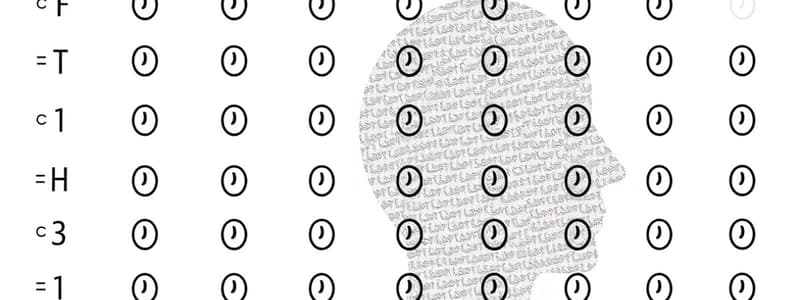Podcast
Questions and Answers
What is reliability in the context of psychological tests?
What is reliability in the context of psychological tests?
Consistency of measures or scores obtained from psychological tests.
What are the types of reliability? (Select all that apply)
What are the types of reliability? (Select all that apply)
- Test-retest reliability (correct)
- Interrater reliability (correct)
- Parallel forms reliability (correct)
- Bias reliability
What is test-retest reliability?
What is test-retest reliability?
Measure of stability of scores over time.
What correlation coefficient value is considered reliable?
What correlation coefficient value is considered reliable?
What factors affect test-retest reliability? (Select all that apply)
What factors affect test-retest reliability? (Select all that apply)
What is parallel forms reliability also known as?
What is parallel forms reliability also known as?
What does interrater reliability measure?
What does interrater reliability measure?
What is Cronbach's alpha used for?
What is Cronbach's alpha used for?
The smaller the standard error of measurement, the more the scores obtained reflects the ______.
The smaller the standard error of measurement, the more the scores obtained reflects the ______.
Higher Cronbach's alpha values always indicate good internal consistency.
Higher Cronbach's alpha values always indicate good internal consistency.
Study Notes
Overview of Reliability
- Reliability refers to the consistency of measures or scores obtained from psychological tests.
- Four major types of reliability: test-retest, parallel forms, interrater, and internal consistency.
Test-Retest Reliability
- Assesses stability of scores over time by administering the same test to the same group after a specific interval.
- Scores are compared using a correlation coefficient, with a threshold of .70 or higher indicating reliability.
Factors Affecting Test-Retest Reliability
- Shorter intervals typically yield more consistent scores due to memory retention.
- Motivation issues can arise, leading to careless responses on retests.
- Practice effects may improve scores on subsequent tests due to prior exposure.
- Variable stability affects reliability; some measures may be inherently less stable over time.
Parallel Forms Reliability
- Also known as alternate forms reliability, evaluates how different versions of the same test yield consistent results.
- Requires the development of two equivalent forms of the test, administered at separate times.
- Correlation between scores of different forms is calculated to assess reliability.
Factors Affecting Parallel Forms Reliability
- Differences in item sampling may yield varying results despite measuring the same construct.
- Reliability can vary based on the time interval between test administrations.
- Developing a second valid and reliable form is resource-intensive and complex.
Interrater Reliability
- Measures agreement between two raters or observers, important in subjective scoring scenarios.
- Raters must be trained to use the tools and scoring criteria consistently.
- Agreement levels are quantified, commonly using the Kappa coefficient, which measures actual agreement versus chance.
Factors Affecting Interrater Reliability
- Rater expertise influences scoring accuracy; unfamiliarity may lead to inconsistent ratings.
- Subjective perceptions and personal experiences affect individual scoring.
- Human factors such as fatigue and mood can impact rater reliability.
Internal Consistency
- Also referred to as split-half reliability, it assesses whether multiple test items measure the same construct.
- Involves splitting the test items into two halves and correlating the scores of each half.
- More items yield better reliability; a high Cronbach’s alpha (≥ .80) indicates strong internal consistency.
Factors Affecting Internal Consistency
- The homogeneity of items is essential; segments must measure the same construct to ensure reliability.
- Method of splitting items is important; for example, splitting by odd/even numbers can introduce variability due to fatigue.
- Subscales may measure distinct constructs, potentially impacting overall consistency.
Standard Error of Measurement (SEM)
- SEM estimates how repeated measures with the same test reflect the "true" score of an individual.
- Higher reliability and lower standard deviation lead to a smaller SEM, indicating that obtained scores reflect true variance accurately.
- Calculation of SEM utilizes the formula: SEM = SD (√1 – reliability coefficient).
Studying That Suits You
Use AI to generate personalized quizzes and flashcards to suit your learning preferences.
Related Documents
Description
This quiz explores the concept of reliability in psychological testing, showcasing its importance in achieving consistent and accurate results. Topics covered include different types of reliability such as test-retest, parallel forms, interrater, and internal consistency. Understand how these types contribute to the reliability of psychological assessments.




